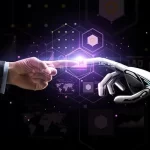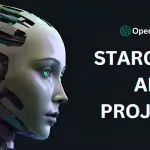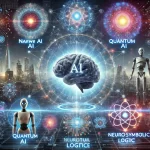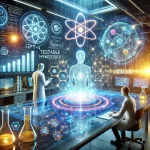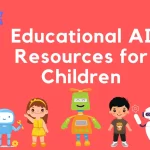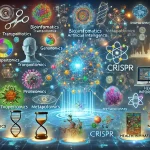
ChatGPT and its implications for the future of AI in life science
December 28, 2023I. Introduction:
A. Overview of ChatGPT and its Capabilities:
ChatGPT is an advanced natural language processing (NLP) model developed by OpenAI. It belongs to the GPT-3.5 architecture, which stands for “Generative Pre-trained Transformer 3.5.” As a language model, ChatGPT is designed to understand and generate human-like text based on the input it receives. It is part of the broader GPT-3 family, known for its large scale, impressive language understanding, and generative capabilities.
Key capabilities of ChatGPT include:
- Natural Language Understanding: ChatGPT can comprehend and interpret human language in a contextually relevant manner. It can understand queries, prompts, and instructions in a wide range of topics.
- Text Generation: ChatGPT excels in generating coherent and contextually appropriate text. It can complete sentences, paragraphs, or even create longer-form content based on the given input.
- Conversation and Interaction: One of its notable features is its ability to engage in dynamic and interactive conversations. It can maintain context over multiple turns, making it suitable for chat-based applications.
- Diverse Applications: ChatGPT finds applications in content creation, writing assistance, answering questions, language translation, and various other tasks that involve natural language interactions.
B. Importance of AI in Life Science and the Impact of ChatGPT on the Field:
- Accelerating Research:
- ChatGPT, with its natural language understanding, can assist researchers in quickly accessing relevant information, literature, and resources in life sciences. This accelerates the pace of scientific discovery.
- Enhanced Collaboration:
- ChatGPT facilitates communication and collaboration among researchers by providing a tool for generating and sharing ideas, hypotheses, and insights in a natural language format.
- Literature Review and Information Retrieval:
- Researchers can leverage ChatGPT to efficiently conduct literature reviews and retrieve information from vast scientific databases. It aids in staying updated with the latest research findings.
- Idea Generation and Hypothesis Formulation:
- ChatGPT’s text generation capabilities assist scientists in brainstorming and formulating hypotheses. It provides a platform for creative thinking and ideation in the life sciences.
- Communication with Non-Experts:
- ChatGPT can bridge the gap between experts and non-experts in life science by translating complex concepts into more accessible language. This promotes better communication and understanding across diverse audiences.
- Educational Support:
- In educational settings, ChatGPT can serve as a virtual tutor, helping students and learners in the life sciences domain by providing explanations, answering queries, and offering study assistance.
- Efficient Documentation:
- ChatGPT aids in the efficient creation of documentation, research reports, and summaries in natural language. Researchers can articulate and document their findings more effectively.
- Innovation in Drug Discovery:
- In the pharmaceutical industry, ChatGPT’s capabilities can contribute to innovative approaches in drug discovery by assisting in literature review, hypothesis generation, and data interpretation.
In summary, ChatGPT plays a significant role in leveraging AI for the life sciences, enhancing communication, collaboration, and information retrieval. Its impact extends to various aspects of research, education, and innovation in the field, contributing to the advancement of life sciences through the power of natural language processing.
II. ChatGPT and Natural Language Processing:
A. Explanation of ChatGPT’s Use of Natural Language Processing:
- Transformer Architecture:
- ChatGPT is built on the transformer architecture, specifically the GPT-3.5 variant. Transformers are deep learning models that excel at capturing contextual relationships in sequences of data, making them well-suited for natural language processing (NLP) tasks.
- Pre-trained Model:
- ChatGPT is pre-trained on a vast corpus of diverse text from the internet. This pre-training allows it to learn grammar, context, and world knowledge, enabling it to generate human-like text.
- Fine-Tuning for Specific Tasks:
- While pre-training provides a broad understanding of language, ChatGPT can be fine-tuned for specific applications, including those in life science. Fine-tuning tailors the model to perform more effectively in targeted domains.
- Token-Based Processing:
- ChatGPT processes input and generates output based on tokens, which can be as short as a single character or as long as a word. This token-based approach allows it to handle various text lengths and complexities.
- Contextual Understanding:
- One of the strengths of ChatGPT is its contextual understanding. It considers the entire context of a conversation or prompt, enabling it to generate responses that are contextually relevant and coherent.
B. Potential Applications in Life Science:
- Literature Review and Information Retrieval:
- ChatGPT can assist researchers in the life sciences by summarizing research papers, answering specific queries, and retrieving relevant information from scientific databases, expediting literature review processes.
- Collaborative Research:
- Researchers can use ChatGPT to facilitate collaborative efforts, allowing for seamless communication and idea exchange. It serves as a virtual collaborator for brainstorming and refining research hypotheses.
- Data Interpretation:
- In life science research, where data interpretation is crucial, ChatGPT can help researchers make sense of complex datasets. It can provide insights and explanations based on its understanding of the input data.
- Educational Support:
- ChatGPT can be employed as an educational tool in life science courses. It assists students by explaining concepts, answering questions, and providing additional information in a conversational manner.
- Idea Generation and Hypothesis Formulation:
- Researchers can use ChatGPT to spark new ideas and formulate hypotheses. By interacting with the model, scientists can explore different angles and possibilities in their research.
C. Changing the Way We Interact with AI:
- Conversational AI:
- ChatGPT represents a shift towards more natural and conversational interactions with AI. Users can communicate with the model in a manner that resembles everyday conversation, making it accessible to a broader audience.
- User-Friendly Interaction:
- The conversational nature of ChatGPT makes it user-friendly. Users can input queries, prompts, or requests in plain language, eliminating the need for complex programming or specific commands.
- Dynamic and Contextual Responses:
- Unlike traditional rule-based systems, ChatGPT generates responses dynamically based on the context of the conversation. This enables more fluid and natural interactions, enhancing the user experience.
- Versatile Applications:
- ChatGPT’s versatility allows it to be applied across various domains. Its natural language capabilities make it adaptable to diverse tasks, from content creation and customer support to research collaboration and education.
- Continual Learning and Adaptation:
- ChatGPT can adapt to user input and preferences over time, leading to a personalized interaction experience. It continuously learns from its interactions, improving its responses and understanding of user intent.
In essence, ChatGPT’s natural language processing capabilities redefine the way we engage with AI, offering a conversational and versatile tool for a wide range of applications, including those in the intricate and dynamic field of life science. Its potential to assist researchers, educators, and students highlights the transformative impact of natural language processing in the realm of AI.
III. Applications of ChatGPT in Life Science:
A. Examples of How ChatGPT is Being Used in Life Science Research and Development:
- Drug Discovery:
- Literature Review: ChatGPT assists researchers in conducting comprehensive literature reviews, extracting relevant information from scientific papers, and staying updated on the latest findings in drug discovery.
- Diagnostic Tools:
- Conversational Diagnostics: ChatGPT can be integrated into diagnostic tools to provide a conversational interface for healthcare professionals and patients, aiding in symptom assessment and preliminary diagnostics.
- Bioinformatics:
- Data Interpretation: Researchers use ChatGPT to interpret complex bioinformatics data, helping in the analysis of genomic, transcriptomic, and proteomic datasets for insights into molecular mechanisms and biological pathways.
- Collaborative Research:
- Virtual Collaborator: ChatGPT serves as a virtual collaborator for researchers, facilitating communication and idea exchange. It assists in refining research hypotheses, brainstorming, and fostering collaborative efforts.
- Educational Support:
- Virtual Tutor: ChatGPT aids in education by serving as a virtual tutor for life science students. It answers questions, explains concepts, and provides additional information in a conversational manner, enhancing the learning experience.
- Semantic Search in Biomedical Databases:
- Clinical Decision Support:
- Patient Interaction: In clinical settings, ChatGPT assists healthcare professionals by providing information on treatment options, explaining medical concepts, and offering support in shared decision-making with patients.
B. Emerging Trends and Opportunities for ChatGPT in Life Science:
- Customized Chatbots for Patient Engagement:
- Healthcare Chatbots: The development of specialized chatbots powered by ChatGPT offers opportunities for patient engagement, providing personalized health information, medication reminders, and support for chronic disease management.
- Natural Language Interfaces for Laboratory Automation:
- Laboratory Processes: ChatGPT could be integrated into laboratory automation systems, offering natural language interfaces for researchers to interact with and control laboratory processes, enhancing efficiency and ease of use.
- Clinical Trial Support:
- Patient Recruitment: ChatGPT can assist in patient recruitment for clinical trials by providing information to potential participants and addressing queries, contributing to the acceleration of clinical research.
- Interactive Scientific Communication:
- Science Communication: ChatGPT enables researchers to communicate their findings in a more accessible and interactive manner, bridging the gap between scientific experts and the general public.
- Personalized Medicine Guidance:
- Treatment Guidance: As ChatGPT evolves, it could play a role in personalized medicine by offering guidance on treatment options based on individual patient data, contributing to more tailored and effective healthcare strategies.
- Real-time Collaboration in Research:
- Virtual Research Assistant: ChatGPT could act as a real-time virtual research assistant, aiding scientists in experimental design, data interpretation, and collaborative writing, fostering a more dynamic and efficient research environment.
- Language Translation in Multinational Collaborations:
- Cross-Cultural Collaboration: ChatGPT’s language translation capabilities can facilitate multinational collaborations in life science research, breaking down language barriers and promoting global cooperation.
The emerging trends and opportunities for ChatGPT in life science indicate a growing potential for AI-driven advancements in research, diagnostics, and patient engagement. As the technology continues to evolve, it is likely to contribute significantly to the way life science professionals interact with information, collaborate, and make informed decisions in their respective fields.
IV. Ethical and Societal Implications:
A. Broader Societal Implications of ChatGPT in Life Science:
- Job Displacement:
- The integration of ChatGPT in tasks like literature reviews and information retrieval could lead to changes in job roles for researchers and assistants. While it may enhance efficiency, there could be concerns about potential job displacement.
- Impact on Healthcare Accessibility:
- If ChatGPT is utilized in diagnostic tools or as a support tool in healthcare, its impact on accessibility needs careful consideration. There may be disparities in access to AI-driven healthcare tools, affecting different demographics.
- Expertise Dependency:
- Overreliance on ChatGPT for interpreting complex data might lead to a dependency on the technology, potentially diminishing the cultivation of human expertise in data interpretation within the life sciences.
B. Potential Regulations or Guidelines:
- Data Privacy and Security:
- Regulations ensuring the privacy and security of sensitive healthcare data processed by ChatGPT are crucial. Guidelines should mandate secure storage, transmission, and processing of patient information.
- Transparency and Explainability:
- Guidelines should be established to ensure transparency in the use of ChatGPT, especially in critical applications like diagnostics. Users and patients should have access to understandable explanations of how decisions are made.
- Equitable Access:
- To address potential disparities, regulations should encourage equitable access to ChatGPT-powered tools and technologies, ensuring that benefits are distributed across diverse populations and healthcare settings.
- Guardrails for Decision Support:
- In clinical decision support, clear guidelines should be in place to distinguish the role of ChatGPT from that of healthcare professionals. The tool should be positioned as a support system, and ultimate decisions should rest with qualified professionals.
- Responsible Research Practices:
- Regulations could mandate responsible practices in research collaborations involving ChatGPT. This includes guidelines for ethical data sharing, authorship attribution, and ensuring that the technology is used ethically in collaborative endeavors.
- Addressing Bias and Fairness:
- Guidelines should require developers to actively address and mitigate biases in ChatGPT to ensure fair and unbiased outcomes, particularly in applications related to healthcare where bias could have significant consequences.
- Continuous Monitoring and Assessment:
- Regular assessments and monitoring of ChatGPT’s impact on job roles, healthcare outcomes, and accessibility should be mandated. This helps in identifying potential issues and adjusting regulations as needed.
- Informed Consent and User Education:
- In applications involving patient interactions, regulations should emphasize the importance of informed consent and user education. Patients should be aware of the involvement of AI like ChatGPT in their healthcare processes.
- International Collaboration and Standards:
- Given the global nature of life science research, international collaboration on ethical standards and guidelines for ChatGPT use is essential. Harmonizing standards can ensure consistency and interoperability.
- Public Input and Ethical Review:
- Regulations could mandate processes for public input and ethical review boards to assess the societal impact of ChatGPT in life science. This can help in incorporating diverse perspectives and addressing ethical concerns.
By proactively addressing these ethical and societal considerations through well-defined regulations and guidelines, the deployment of ChatGPT in life science can be more responsible, transparent, and aligned with the broader goals of enhancing healthcare and scientific research while minimizing potential negative consequences.
V. The Future of AI in Life Science:
A. Potential Long-Term Implications of ChatGPT and Other AI Systems:
- Accelerated Scientific Discovery:
- The integration of advanced AI systems like ChatGPT holds the promise of accelerating scientific discovery in life science. AI can sift through vast datasets, identify patterns, and generate hypotheses, leading to faster breakthroughs.
- Precision Medicine Advancements:
- Long-term implications include advancements in precision medicine, where AI-driven tools like ChatGPT contribute to the personalized analysis of individual patient data, leading to more tailored treatment strategies.
- Enhanced Drug Discovery and Development:
- AI systems can revolutionize drug discovery by predicting drug candidates, optimizing molecular structures, and expediting the development process. The long-term impact may result in a more efficient and cost-effective drug development pipeline.
- Patient-Centric Healthcare:
- AI has the potential to shift healthcare towards a more patient-centric model. The integration of ChatGPT in healthcare settings could lead to improved patient interactions, personalized health recommendations, and better-informed decision-making.
- Data-Driven Insights for Public Health:
- AI systems can contribute to a more data-driven approach to public health. Long-term implications include the use of AI to analyze population health data, predict disease outbreaks, and inform public health interventions.
B. Possibilities for Further Development and Improvement of ChatGPT and Other AI Systems in Life Science:
- Enhanced Natural Language Understanding:
- Continuous development efforts should focus on improving the natural language understanding capabilities of AI systems like ChatGPT. This involves refining contextual understanding, language nuances, and context retention over longer conversations.
- Domain-Specific Specialization:
- Future development could involve fine-tuning ChatGPT for specific life science domains to enhance its expertise in areas such as genomics, proteomics, or bioinformatics. This specialization ensures more accurate and domain-specific responses.
- Integration of Multimodal Data:
- AI systems can evolve to integrate multimodal data, combining text-based information with images, graphs, and other data types. This integration enhances the ability to interpret and generate insights from diverse datasets in life science.
- Explanability and Transparency:
- Addressing the challenge of explainability remains crucial. Future iterations of AI systems should prioritize providing clear explanations for generated responses, especially in healthcare and life science applications where interpretability is paramount.
- Active Learning and User Feedback Incorporation:
- AI systems can be designed to actively learn from user feedback. Incorporating mechanisms for users to correct or validate responses helps in continuous improvement and ensures that the system adapts to user-specific preferences and needs.
- Diversity and Ethical Considerations:
- Future development should emphasize addressing biases and ensuring diversity in training data. This involves incorporating ethical considerations into the development process to mitigate potential biases in AI-generated content.
- Real-Time Collaboration Features:
- Enhancements can be made to facilitate real-time collaboration features, allowing ChatGPT to seamlessly integrate into collaborative research environments. This involves supporting dynamic brainstorming, idea generation, and content creation in a collaborative setting.
- Integration with Experimental Design Tools:
- AI systems can be further developed to integrate with experimental design tools in life science. This involves assisting researchers in planning experiments, analyzing results, and interpreting data in a more integrated and streamlined manner.
- Security and Privacy Enhancements:
- Continued development should prioritize robust security measures and privacy-enhancing features. This ensures that sensitive healthcare and research data processed by AI systems remains secure and complies with regulatory standards.
- Cross-Disciplinary Collaboration:
- Future developments could encourage cross-disciplinary collaboration between AI experts and life science researchers. This collaborative approach ensures that AI systems are designed with a deep understanding of the unique challenges and requirements of the life sciences.
In conclusion, the future of AI in life science holds significant promise, with the potential for transformative impacts on research, healthcare, and drug development. Further development and improvement of AI systems, including ChatGPT, should be guided by a commitment to ethical considerations, user feedback, and a focus on addressing domain-specific challenges in the dynamic field of life science.
VI. Conclusion:
In conclusion, the exploration of ChatGPT and AI in life science reveals a landscape of innovation, opportunities, and ethical considerations. Key points covered in the article can be summarized as follows:
A. Summary of Key Points:
- ChatGPT Overview:
- ChatGPT, based on the GPT-3.5 architecture, is an advanced natural language processing model developed by OpenAI. It excels in understanding and generating human-like text in a conversational manner.
- Applications in Life Science:
- ChatGPT finds applications in various facets of life science research, including drug discovery, diagnostic tools, literature review, collaborative research, and educational support.
- Natural Language Processing Capabilities:
- The model’s natural language processing capabilities enable researchers to interact with AI in a more conversational and user-friendly manner, potentially transforming the way information is accessed and communicated.
- Ethical and Societal Implications:
- Broader societal implications include considerations of job displacement, healthcare accessibility, and the need for regulations to ensure responsible and ethical use of ChatGPT in life science.
- Future of AI in Life Science:
- The future of AI in life science holds promises of accelerated scientific discovery, precision medicine advancements, and enhanced drug discovery. However, long-term implications also raise questions about job roles, accessibility, and expertise dependency.
B. Potential Benefits and Challenges:
- Potential Benefits:
- Accelerated Research: ChatGPT can expedite literature reviews, information retrieval, and collaboration, leading to faster scientific discoveries.
- Precision Medicine: AI systems have the potential to contribute to more personalized and effective healthcare strategies.
- Drug Discovery: The integration of AI can revolutionize drug discovery processes, making them more efficient and cost-effective.
- Enhanced Collaboration: ChatGPT facilitates collaborative efforts, acting as a virtual collaborator for researchers in diverse domains.
- Challenges:
- Job Displacement: The integration of AI may lead to changes in job roles, raising concerns about potential job displacement in certain domains.
- Healthcare Accessibility: There are considerations about disparities in access to AI-driven healthcare tools, impacting different demographics.
- Expertise Dependency: Overreliance on AI for data interpretation might diminish the cultivation of human expertise in the life sciences.
In navigating these challenges, it becomes crucial to establish regulations and guidelines that address ethical considerations, transparency, and equitable access to AI technologies. The long-term impact of AI in life science will depend on how stakeholders collaboratively shape its development, ensuring that it aligns with ethical standards and societal values. The potential benefits, when harnessed responsibly, hold the promise of transformative advancements in the pursuit of knowledge and improved healthcare outcomes.



